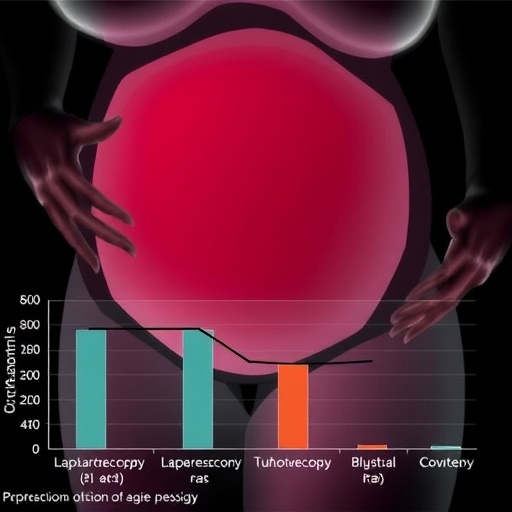In a groundbreaking meta-analysis published in BioMedical Engineering OnLine, researchers have unveiled compelling evidence comparing the clinical efficacy and reproductive outcomes of laparoscopic surgery versus methotrexate treatment for tubal pregnancy. This extensive review synthesizes data from over a thousand patients, providing an unprecedented evaluation of how these two treatment modalities influence fertility function, an area previously shrouded in uncertainty.
Ectopic pregnancy, particularly tubal pregnancy, continues to pose significant clinical challenges due to the delicate balance required between resolving the immediate threat to the patient’s health and preserving future fertility potential. Traditionally, methotrexate, a chemotherapeutic agent that halts trophoblastic cell division, has been the cornerstone of medical management for many patients. Conversely, laparoscopic surgery presents a more invasive option aimed at physically removing the aberrant pregnancy tissue while potentially sparing the fallopian tube.
The meta-analysis meticulously combed through five major English-language databases and four prominent Chinese-language repositories, scrutinizing studies published up to January 31, 2024. This methodical investigation incorporated ten rigorous trials encompassing 1,034 subjects, ensuring that the findings rest on a robust and diverse patient population. Their use of Review Manager 5.3 for statistical analysis ensured that the data were synthesized with methodological precision.
One of the most striking findings was the substantially higher tubal patency rate with laparoscopic surgery compared to a single intramuscular dose of methotrexate. Tubal patency, the openness and functionality of the fallopian tube, is a critical determinant of natural fertility, and enhanced patency rates suggest that surgical intervention may better preserve reproductive anatomy. The odds ratio of 2.47, with a confidence interval ranging from 1.72 to 3.53 and a P-value below 0.001, highlights a statistically and clinically significant advantage favoring surgery.
Further cementing the superiority of surgical intervention in fertility preservation, the spontaneous pregnancy rate post-treatment was also notably higher in the laparoscopic group. The odds ratio of 2.10 demonstrates a doubled chance of natural conception when compared with methotrexate treatment, underscoring the procedural benefit. Such enhanced fertility outcomes bear immense importance for patients desirous of childbearing, influencing treatment decision-making in the clinical setting.
The kinetics of serum human chorionic gonadotropin (HCG) normalization—a biomarker for resolving ectopic pregnancy—also favored laparoscopy, with a significantly shorter time to reach normal levels. This suggests a more rapid resolution of pregnancy-related hormonal disturbances, which might correlate with faster recovery and fewer complications. The mean difference of -7.10 days indicates an accelerated biochemical clearance with surgical management.
Interestingly, when evaluating treatment success rates, the analysis found no statistically significant difference between the two approaches. This parity indicates that both laparoscopic surgery and methotrexate can be effective in resolving tubal pregnancy from a clinical standpoint, corroborating existing evidence on their safety profiles and efficacy. However, success here is essentially defined by resolution, without considering long-term reproductive outcomes.
Additionally, the rates of recurrent ectopic pregnancy did not differ significantly between the two groups. This finding suggests that despite the apparent advantages in tubal function and fertility with surgery, the risk of repeat ectopic gestation remains comparable. This information is crucial for counseling patients about their prognosis and the potential need for vigilant follow-up irrespective of treatment choice.
The clinical implications of these findings are far-reaching. For the reproductive endocrinologist or gynecologic surgeon, such evidence guides nuanced discussions with patients balancing immediate treatment success, fertility goals, and risks associated with surgical intervention. While methotrexate offers a non-invasive route, the demonstrated superior fertility outcomes with laparoscopic surgery may tilt the scales for many seeking future pregnancies.
From a technical perspective, laparoscopic surgery entails excision or repair of the fallopian tube under direct visualization, enabling removal of ectopic tissue while minimizing damage to adjacent ovarian and tubal structures. Advances in minimally invasive techniques now afford reduced postoperative pain, shorter hospital stays, and a swift return to normal activities, making it an increasingly attractive option.
Conversely, methotrexate therapy, typically delivered via a single intramuscular injection, is favored for its simplicity, outpatient feasibility, and avoidance of surgical risks. Nevertheless, its success hinges on strict patient selection criteria, including stable hemodynamics and low initial HCG levels, limiting its universal applicability.
The meta-analysis authors prudently conclude that while laparoscopic surgery exhibits superior fertility preservation metrics compared to methotrexate, further research is warranted to fully elucidate differences in overall clinical efficacy. Given the variability in study designs, patient characteristics, and follow-up durations, future high-quality randomized controlled trials with uniform protocols are imperative.
Ultimately, this seminal work underscores the evolving landscape of ectopic pregnancy management, integrating surgical advancements with medical therapy to optimize patient outcomes. Healthcare providers must remain abreast of these developments, tailoring treatment plans that harmonize disease resolution with the paramount goal of fertility preservation.
As clinical practice evolves, the intersection of data-driven medicine and patient-centered care will continue to refine therapeutic strategies for tubal pregnancy. This meta-analysis marks a pivotal step in clarifying critical aspects of treatment efficacy and reproductive impact, providing a foundation for informed clinical decisions and improved patient quality of life.
Subject of Research:
Article Title: The clinical efficacy and impact on fertility function of laparoscopic surgery versus methotrexate for treatment of tubal pregnancy: a meta-analysis
Article References: Lin, S., Lin, R. & Liu, H. The clinical efficacy and impact on fertility function of laparoscopic surgery versus methotrexate for treatment of tubal pregnancy: a meta-analysis. BioMed Eng OnLine 24, 134 (2025). https://doi.org/10.1186/s12938-025-01437-x
Image Credits: AI Generated
DOI: 11 November 2025




